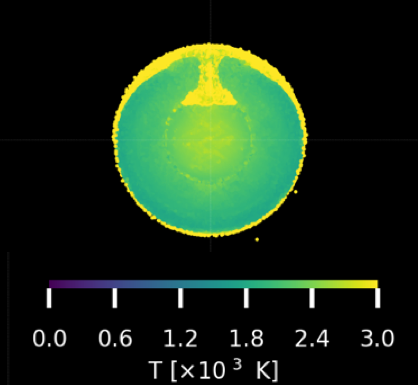Forming the Martian Crustal Dichotomy Without Significant Mantle Heating
- Universität Bern, Physics, Space Research & Planetary Sciences (WP), Bern, Switzerland (harry.ballantyne@space.unibe.ch, martin.jutzi@space.unibe.ch)
Introduction
Almost 50 years ago, NASA’s Mariner 9 space probe performed the first complete orbit of a planet other than Earth. This was around our smaller celestial neighbour – Mars. Along the way, this spacecraft obtained images of approximately 85% of the planet’s surface in unprecedented detail, revealing a stark contrast between the northern and southern hemispheres now known as the martian crustal dichotomy. This moniker predominantly refers to the 4-8 km difference in elevation between the southern hemisphere and an apparent basin covering roughly 42% of the north. Other associated features include a higher density of volcanoes and visible impact craters in the south relative to the north.
Some studies have attempted to explain these properties through endogenic means; namely via degree-1 mantle convection studied using large-scale thermochemical models (e.g. Keller and Tackley, 2009). Others have taken the exogenic route, proposing that a giant impact early in Mars’ history caused the excavation of a large mass of material from the northern hemisphere, thus giving rise to the observed dichotomy (e.g. Marinova et al., 2008). Given that such collisions are expected to be very common in the final stages of terrestrial planetary accretion, this approach is highly feasible. The latter studies have, however, generally ignored any long-term geodynamical consequences on the martian interior that such an event may cause.
Recent work has proved the importance of coupling these methods, introducing a hybrid exogenic-endogenic scenario whereby a giant impact triggered a localized magma ocean and subsequent superplume in the southern hemisphere (Golabek et al., 2018). This hypothesis has, however, only been investigated using a very limited range of initial parameters, all of which lead to significant heating deep into the mantle. This therefore motivates an interesting area of study – could there be a parameter space that leads to a hemispherically-thickened crust without significantly heating the mantle? We aim to answer this question using a suite of smoothed-particle hydrodynamics (SPH) simulations that explore a large parameter-space chosen with the intention of limited internal heating, allowing us to neglect any long-term geodynamical effects with reasonable confidence.
Method
The chosen initial parameters for the main suite of SPH simulations are as follows: impact angles of 0-90° in steps of 15°; impact velocities of 1.0, 1.2 and 1.4 times the mutual escape speed; impactor radii of 1000km, 1500km and 2000km; and relative core masses of 25% and 50%. All of these simulations use a resolution of 200,000 SPH particles, with near head-on collisions (0-30°) being modelled for 50 hours after impact and oblique collisions (45-90°) for 200 hours to allow for any secondary (or even tertiary) impacts. In addition, a smaller set of high resolution (1,000,000 SPH particle) simulations are being used to investigate extremely low-velocity (less than mutual escape speed) collisions in a bid to quantitively identify the transition from impacts of large-scale mantle heating to those of relatively cool accretionary piles similar to those described in Jutzi and Asphaug (2011). This then allows for discussion of the potential mechanisms that could lead to such events and their feasibility.
Each model includes the effects of shear strength and plasticity (via a Drucker-Prager-like yield criterion) as such effects have been shown to be significant on the scales concerned in this study (Emsenhuber et al., 2018). Moreover, the sophisticated equation of state ANEOS is being used along with a Mars-specific solidus (Duncan et al., 2018) to accurately calculate the physical environment in which such solid characteristics must be considered.
In all of these studies, both Mars and the impactor are treated as differentiated bodies composed of an iron core and a silicate mantle. An example result of one of these simulations can be seen in Figure 1.

Figure 1: The resulting temperature field of a Mars-like body from a 106 particle SPH simulation 12hr after an impact with a ≈1000km radius impactor at a 0° impact angle and a velocity of 80% of the mutual escape speed.
Preliminary Results
The initial results of this study have revealed promising hemispherical features in certain cases, particularly when examining the melt distribution in the upper mantle. Of notable interest are the results of the grazing impact angles, as some of the initial kinetic energy of the impactor is converted to rotational energy of Mars, allowing for subsequent merging events of decreased impact velocity. In addition, the effects of material strength have been found to be non-negligible, in contrast to previous beliefs that such aspects can be ignored on the length-scales involved in planetary collisions.
References
Canup, R. and Salmon, J. (2018). Origin of Phobos and Deimos by the impact of a Vesta-to-Ceres sized body with Mars. Science Advances, 4(4).
Duncan, M. S., Schmerr, N. C., Bertka, C. M., and Fei, Y. (2018). Extending the Solidus for a Model Iron-Rich Martian Mantle Composition to 25 GPa. Geophysical Research Letters, pages 211–220.
Emsenhuber, A., Jutzi, M., and Benz, W. (2018). SPH calculations of Mars-scale collisions: The role of the equation of state, material rheologies, and numerical effects. Icarus, 301:247–257.
Golabek, G. J., Emsenhuber, A., Jutzi, M., Asphaug, E., I., and Gerya, T. V. (2018). Coupling SPH and thermochemical models of planets: Methodology and example of a Mars-sized body. Icarus, 301:235–246.
Jutzi, M. and Asphaug, E. (2011). Forming the lunar farside highlands by accretion of a companion moon. Nature, 476(7358), 69-72.
Keller, T. and Tackley, P. J. (2009). Towards selfconsistent modeling of the martian dichotomy: The influence of one-ridge convection on crustal thickness distribution. Icarus, 202(2):429–443.
Marinova, M. M., Aharonson, O., and Asphaug, E. (2008). Mega-impact formation of the Mars hemispheric dichotomy. Nature, 453(7199):1216–1219.
Murchie, S. L., Thomas, P. C., Rivkin, A. S., and Chabot, N. L. (2015). Phobos and Deimos.
How to cite: Ballantyne, H. and Jutzi, M.: Forming the Martian Crustal Dichotomy Without Significant Mantle Heating, Europlanet Science Congress 2020, online, 21 Sep–9 Oct 2020, EPSC2020-665, https://doi.org/10.5194/epsc2020-665, 2020.

